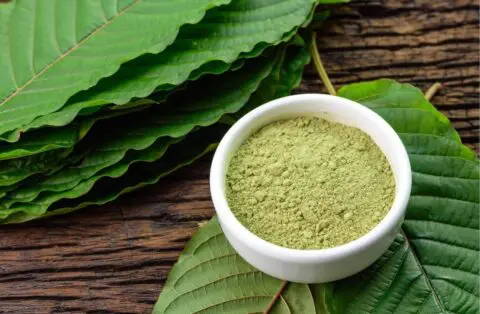What you’ll learn
We’ll break down exactly how 7-OH affects your brain differently from other opioids, why Suboxone® can be effective for treating opioid use disorder and kratom use disorder, and what to expect during the transition. You’ll learn about why some people experience intense withdrawal when switching, and how QuickMD makes the process safer and more manageable.
Kratom or 7-OH might sound like just another herbal supplement. But people dealing with kratom dependence or concentrated kratom products, like 7-OH, know better. What starts as chronic pain relief or help with opioid withdrawal can gradually become something much harder to control than expected.
More and more people are recognizing that kratom and 7-OH or 7-hydroxymitragynine (a concentrated derivative of kratom) share the same psychoactive ingredients, with 7-OH being a stronger, more concentrated form.
7-OH is the most potent alkaloid in kratom, and products made with it usually contain far higher concentrations than what naturally occurs in the plant. A useful comparison is alcohol: both beer and whiskey contain alcohol, yet an ounce of whiskey is much stronger than an ounce of beer. In the same way, 7-OH, often produced and sold as kratom, can act like a much more powerful version of the plant itself.
What many people don’t realize is that this has created a growing number of kratom use disorder cases, often in people who turned to kratom thinking it was a safer, natural alternative to prescription pain medications.
The compound binds to the same brain receptors as morphine and heroin, and for many, stopping has become unexpectedly difficult.
But Suboxone (buprenorphine/naloxone) can be an effective treatment for treating kratom addiction and 7-OH dependence. But the process isn’t always straightforward, and understanding why requires looking at how these substances work in your brain.
At QuickMD, we work with those who are dealing with kratom use disorder and going through the transition from kratom and 7-OH to medically supervised treatment. We understand the unique challenges of 7-OH dependence and can help you find a safer path forward. We’ve helped hundreds of patients safely switch to Suboxone from opioids and other substances and understand the specific challenges this transition presents, particularly when higher doses are involved.
But before we talk about treatment, it helps to understand what you’re actually dealing with. The reason 7-OH feels so different from regular kratom, and why it can be so hard to stop, comes down to what’s happening in your brain.
How Suboxone (buprenorphine/naloxone) works for kratom use disorder and 7-OH addiction
To understand why Suboxone works for kratom and 7-OH addiction, you need to know what makes 7-OH unique.
As we explored in our previous article about kratom and 7-OH, this compound is far more potent than regular kratom alkaloids.
7-OH is a potent mu-opioid receptor agonist, activating the same brain receptors as traditional opioids. In animal studies, it’s shown to be up to 13 times more potent than morphine. When you use products containing concentrated 7-OH, it can act like a powerful opioid, even though it comes from a plant and not a pill.
Researchers at Columbia University discovered that while mitragynine (regular kratom’s main compound) makes up two-thirds of kratom’s content, 7-OH is actually five times more potent than mitragynine when taken orally.
Here’s how 7-OH is different:
- Longer duration: 7-OH stays in your system longer than many illicit opioids. That means withdrawal follows a different timeline. While heroin withdrawal might peak within days, 7-OH can create a more drawn-out process that catches people off guard.
- Receptor binding: While it hits the same mu-opioid receptors, 7-OH also interacts with other brain systems, including some that affect mood and anxiety differently than traditional opioids.
- Variable potency: Unlike pharmaceutical opioids with consistent dosing, kratom products containing 7-OH have wildly inconsistent potency levels, making it harder to predict effects or manage tolerance.
This combination of high potency and inconsistent dosing is part of why some people find 7-OH dependence particularly challenging to overcome without medical support.
The good news is that understanding how 7-OH works also helps explain why Suboxone can be so effective against it. It’s all about giving your brain what it needs without the dangerous highs and lows.
Kratom vs. 7-OH: quick comparison
| Category | Regular Kratom | 7-OH Products (Concentrated Kratom) |
| Potency | Mild to moderate opioid-like effects | Extremely potent |
| Addiction Risk | Often underestimated | High, acts like a full opioid |
| Withdrawal | Flu-like symptoms | Intense and prolonged |
| Product Source | Raw plant material (inconsistent potency) | Highly concentrated, lab-manipulated extract |
| Overdose Risk | Low but present | Much higher, due to potency and variability |
| Quitting Difficulty | Sometimes manageable | Often requires medical treatment |
Understanding kratom use disorder
Kratom use disorder happens when people become dependent on kratom products. Most people don’t see it coming because kratom might feel “natural” and safe.
Here’s what kratom use disorder looks like:
- Tolerance: You need more kratom to get the same relief
- Withdrawal: You feel sick, anxious, or restless when you try to stop
- Difficulty cutting back: You’re using more than you planned, or can’t cut back
- Using despite problems: Kratom is causing issues with work or relationships, but you keep using it
- Cravings: You think about kratom throughout the day
Kratom use disorder often sneaks up on people. You might have started using kratom for chronic pain or anxiety, or to avoid prescription opioids. But somewhere along the way, it stopped being a choice. The concentrated 7-OH products make this worse. Since they work like traditional opioids in your brain, you can end up with the same dependence you were trying to avoid.
7-OH’s legal status and safety concerns
Kratom from Southeast Asia has gained popularity as a legal alternative to controlled substances, but that doesn’t mean it’s safe or regulated. The Food and Drug Administration (FDA) hasn’t approved kratom products, and they’re sold as herbal supplements with basically no oversight.
This creates real problems. The kratom product you buy today might be completely different from what you bought last month. The FDA has warned about kratom multiple times, specifically calling out respiratory depression risks and serious adverse events like seizures and liver problems.
Federal health officials are taking notice of these side effects. In July 2025, Health Secretary Robert F. Kennedy Jr. announced that the government plans to restrict 7-OH products, with FDA Commissioner Dr. Marty Makary stating the agency would begin the process to officially schedule 7-OH as a controlled substance.
This regulatory shift highlights exactly why medical treatment makes sense. Rather than continuing with an unregulated supplement of unknown strength that may soon be restricted anyway, Suboxone offers consistency and safety.
How Suboxone works for 7-OH addiction and kratom use disorder
Suboxone works differently from 7-OH because it contains buprenorphine, which only partially turns on your brain’s opioid receptors. While 7-OH fully activates these receptors, buprenorphine gives you just enough activation to feel stable without the intense highs and lows.
At the same time, buprenorphine blocks other opioids from taking effect. This means that once you’re on Suboxone, taking 7-OH won’t produce the same results since the buprenorphine is already occupying those brain receptors.
Most importantly, unlike 7-OH use with its peaks and valleys, Suboxone provides steady, long-lasting relief. Recent medical research backs up what we see in practice.
Clinical evidence: Suboxone works for 7-OH addiction and kratom use disorder
Recent clinical studies confirm that Suboxone is effective for treating 7-OH dependence and kratom use disorder. A published case report showed successful treatment of kratom addiction with buprenorphine/naloxone, which “helped alleviate withdrawal symptoms and allowed [the patient] to abstain from kratom”.
Doctors followed 28 people who were struggling with kratom addiction. Most of them did well when they started with a low dose of Suboxone and gradually increased it.
This research showed:
- 15 patients reported significant relief from withdrawal symptoms and cravings at their second appointment.
- None of the people in the study experienced sudden, severe withdrawal when they started Suboxone with proper medical help.
- Most people felt steady and comfortable on their Suboxone dose within 2-3 weeks. This is normal. Your body just needs time to adjust.
Multiple case reports have described successful treatment outcomes with buprenorphine and buprenorphine/naloxone for kratom withdrawal, making this an evidence-based approach rather than an experimental treatment.
Why 7-OH addiction and Suboxone experiences differ
The online discussions about Suboxone and 7-OH are all over the place. Success stories sit right next to cautionary tales, which can make it hard to know what to expect.
In recovery communities, you’ll see people describing vastly different experiences: some report taking Suboxone the same day they stopped 7-OH without problems, while others worry about “trading one addiction for another.”
Here’s why you’ll see so many different (but valid) opinions:
- Product variability: Not all kratom products are the same. A person using weak kratom tea isn’t dealing with the same dependency risks as someone using concentrated 7-OH extracts.
- Timing issues: Transitioning from 7-OH to Suboxone requires careful timing to avoid precipitated withdrawal. You might have a more difficult experience if you start too early.
- Dosing confusion: Buprenorphine dosing for 7-OH dependence may need to be different from traditional opioids, and many people don’t have medical guidance.
- Individual differences: People metabolize these substances differently, and what works for one person may not work for another.
- Withdrawal expectations: Some online accounts don’t distinguish between normal transition discomfort and actual treatment failure.
This is why medical supervision makes such a difference. A QuickMD provider can help you time the transition correctly, adjust dosing as needed, and distinguish between expected discomfort and actual problems.
Opioid withdrawal during the 7-OH to Suboxone transition
Clinical research contradicts some of the stories you may have read online about switching from 7-OH to Suboxone, but some people do experience severe withdrawal symptoms during challenging transitions.
The previous study with 28 participants shows realistic expectations:
- Week 1: Most patients (15 out of 28) reported major relief from 7-OH withdrawal symptoms and cravings at their second appointment. Seven patients had moderate withdrawal symptoms that improved once they increased their dose.
- Weeks 2-3: Six patients reported mild, manageable withdrawal symptoms that resolved “after the kratom metabolized out of the system and Suboxone built up in the system.”
- Stabilization period: It took 2-3 weeks for most patients to stabilize, with some needing dose adjustments during this time.
Several factors contribute to more difficult transitions:
- High-dose 7-OH use: Patients in clinical studies were using an average of 92g of kratom daily, much higher than typical recreational use.
- Multiple alkaloid dependence: Kratom contains many compounds beyond 7-OH. Some withdrawal symptoms may come from other alkaloids that Suboxone doesn’t address.
- Timing and dosing: Clinical success depends on proper timing and dosing.
The key is medical supervision. Providers experienced with 7-OH dependence can time your transition to minimize precipitated withdrawal, adjust Suboxone dosing based on your specific use patterns, provide additional comfort medications during the transition, and distinguish between normal adjustment and problematic reactions.
Why medical supervision matters for 7-OH addiction and kratom use disorder
Trying to switch from 7-OH to Suboxone without medical guidance often leads to problems.
Here’s why professional supervision is absolutely crucial:
- Timing is critical: Start Suboxone too early, and you might trigger sudden, intense withdrawal. Wait too long, and you’re struggling unnecessarily when relief is available.
- Dosing is complex: Someone using weak kratom powder needs a completely different approach than someone taking concentrated extracts. 7-OH potency varies so widely that standard Suboxone starting doses might need tweaking.
- Interactions matter: If you’re taking other medications or substances, your QuickMD provider needs to know to ensure safe treatment.
- Monitoring prevents complications: When you’re transitioning between substances, small issues can become big ones fast. Medical supervision means immediate adjustments when something isn’t working right.
- Support improves outcomes: Having a provider who actually understands 7-OH dependence makes a huge difference.
At QuickMD, our providers are familiar with the unique challenges of transitioning from these substances and can provide the guidance needed for a successful switch to Suboxone.
Want to learn more about kratom addiction and recovery? Check out our Learning Center for in-depth articles on 7-OH, withdrawal management, and evidence-based treatment options for opioid addiction.
If you’re ready to explore this option, here’s why we’ve become specialists in helping people make this particular transition.
Why use QuickMD for 7-OH and kratom use disorder treatment
We understand that 7-OH dependence often develops unintentionally. Some of our patients started with kratom to manage chronic pain or to avoid prescription opioids like Percocet, only to find themselves dependent on something unexpectedly powerful.
Our approach to kratom use disorder and 7-OH addiction treatment includes:
- Specialized experience: Our providers have worked with hundreds of people transitioning from these specific substances. We understand the unique kratom withdrawal timeline, effects of 7-OH, and how to start recovery.
- Personalized care: We build your plan around what actually works for your life and situation on your terms.
- Comprehensive support: Beyond Suboxone, we provide counseling and ongoing medical care.
- Judgment-free environment: We know you didn’t set out to become dependent on 7-OH. Whether you’ve been using it for months or years, we’re here to help you move forward, not look backward.
- Convenient access: All appointments happen online when it works for you. No clinic visits, no waiting rooms, no explaining to anyone where you’re going.
Frequently asked questions about taking suboxone for kratom use
What happens if I relapse and use 7-OH while on Suboxone?
If you use 7-OH while on a stable dose of Suboxone, you likely won’t feel the effects as much because buprenorphine blocks other opioids from working. This can actually be protective against relapse, but it doesn’t mean relapse is impossible. If you do relapse, don’t stop taking your Suboxone. Contact your QuickMD provider immediately. They can help you get back on track without judgment and may adjust your treatment plan. Many people experience setbacks during recovery, and that’s okay. Having medical support makes it easier to return to stability quickly.
How addictive is 7-hydroxymitragynine?
7-hydroxymitragynine (7-OH) has major addiction potential, especially in the concentrated forms of Mitragyna speciosa found in many commercial kratom products. It activates the same brain pathways as traditional opioids like morphine and heroin, which creates a strong potential for physical dependence.
Many people are caught off guard by how quickly dependence can develop. Unlike regular kratom leaf, which has milder effects, concentrated 7-OH products can lead to tolerance, cravings, and withdrawal symptoms within weeks of regular use. If you’re finding it difficult to stop using 7-OH or need increasing amounts to feel the same effects, these are signs that dependence has developed, and medical support can help you regain control safely.
Can I take my other medications while transitioning from 7-OH to Suboxone?
Most medications can be continued during the transition, but some require special attention. ADHD medications like Adderall or Vyvanse are generally safe to continue with Suboxone, despite some online concerns. But benzodiazepines, certain antidepressants, and other central nervous system depressants may need dose adjustments. Your QuickMD provider will review all your medications before starting treatment and monitor for any interactions.




